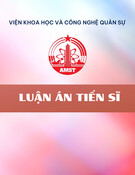MINISTRY OF EDUCATION AND TRAINING MINISTRY OF AGRICULTURE AND RUAL DEVELOPMENT
Luận án sẽ được bảo vệ tại Hội đồng chấm luận án cấp Trường họp tại: Trường Đại học Lâm Nghiệp
Vào hồi ……giờ............ngày............tháng............năm 2021
Có thể tìm hiểu luận án tại thư viện: Thư viện Quốc gia và Thư viện trường Đại học Lâm nghiệp
VIETNAM NATIONAL UNIVERSITY OF FORESTRY –––––––––––***––––––––––– TO QUOC HUY RESEARCH ON TRACTION-GRAPPING CAPACITY AND STABILITY OF TRACTOR WITH COMBINATION OF DISC PLOW WORKING ON STEEP TERRAIN Speciality: Mechanical engineering Code: 9.52.01.03
SUMMARY OF MECHANICAL ENGINEERING DOCTORAL THESIS
Hanoi, 2021
The thesis was conducted at Vietnam Natioonal University of Forestry
Advisors:
Associated professor, Doctor: Nguyen Nhat Chieu Doctor: Đoan Van Thu
Examiner 1:
Examiner 2:
Examiner 3:
The thesis was defended at examinational panel of Vietnam National University of Forestry At:.................................. 2021
The thesis can be found at National library and Vietnam National University of Forest’s library
Hanoi, 2021
PUBLICATIONS
1. To Quoc Huy, Nong Van Vin, Doan Van Thu (2020). “The dynamic
model development of disk plow combined tractor operating along contour lines on steep terrain” Agriculture and Rual Development Journal No16/2020 (ISSN 1859 – 4681).
2. To Quoc Huy, Doan Van Thu, Bui Viet Duc (2020). “The self movement system improvement of a tractor working on farm and forest terrain,” Forest Science Journal No 5/2020, pp 120-132.
3. Doan Van Thu, Nguyen Nhat Chieu (2021). “Experimental study on the determination of traction-gripping capacity and working indicators of the forestry tractor Yanmar F535D,” Forest Science Journal No
1/2021, pp 111-124.
1
INTRODUCTION
1. The necessary of study
Vietnam has a large area of production plantation forest. Up to date 2020, this area is more than 4.3 milliom hectares. In which, the intensive afforestation area of land, which can be mechanized, is more than 1.5 million hectares. There are more than 200 thousand hectares platation forest are harvested and afforested annually. It is very necessary to mechanize production process for improvement of forest productivity and quality. Tractors being used in agriculture and forestry are diversity; however, the traction-gripping and stability are limitation when working on steep terrain. In 2018, Vietnam Forest Institute of Sciences conducted a research project at misterial level “Study, design, and manufacture of some special devices combination of tractors with high level of traction-gripping capacity and stability use for afforesting and forest tending”. Nevertheless, the major contents of this study were concentrated on design, and manufacture of cultivating machines and putting them in to use without in-depth investigation on dynamics and dynamics of pneumacic tyre tractor for land preparation and forest tending on steep terrain in line with condition of forest production in Vietnam. Consequently, it is necessary to conduct the thesis topic “Research on traction-grapping capacity and stability of tractor with combination of disk plow working on steep terrain” 2. Research objective
The influence of some structural factors and utilisation conditions on
traction-gripping capacity and stability is determinated to improve working effeficiency of the rubber-tired agrimotor system assembled with a two- gang disc plow working on steep terrain.
3. Research subject
The subject of this study is a combination of the 53-hp tractor Yanmar F535D with a two gang disc plow (LHM) for forest tending on steep terrain
in Vietnam.
2
4. Scientific and practical significance
Research has developed the dynamics model of a combination of tractor with plow for forest tending on sloping forest land. Based on that,
the effects of some structural factors and utilization conditions has been investigated as a basic for evaluating usability of that combination.
Improved movement system solution for increase in traction-gripping
capacity and stability was proposed as a basis for calculation, design, and the manufacture of movement system of tractor working on sloping forest land. The experimental coefficients related to terrain and soil conditions were
determined such as a rolling resistance coefficient (f), lateral friction coefficient (φx), the resistance force coefficient of plow (Kc). Traction- gripping of movement system was improved by practising. Workability of
LHM in production conditions was assessed. 5. Novel findings of the thesis
The dynamic model of LHM was simulated by the matlab-simulink software using input data is dragging force PC(t) which is function of time obtaining from experimentation. Consequently, the results are closed to actual terrain conditions and soil properties.
Stabilizing direction of tractor working on horizontal slope was
proposed allowing to determine steering angle in order to keeping straight direction movement of tractor on the horizotal slope. This is the basis to establish automatic control program for tractor working on horizontal slope.
The empirical
the gripping-traction study has determined characteristics of the improved self-movement tractor system, the resistance force indicator of plows was also determined for East northerm forest land.
Improved movement system has improved traction-grippng capacity,
stability of LHM working on different conditions.
3
Chapter 1
RESEARCH FIELD OVERVIEW
1.1. Mechanization of afforestation and forest tending
Mechanization of afforestation and forest tending is utilization of machines, equipment for land preparation, weeding, up-hold, fertilizing, pruning, pesticide spraying, watering, etc. Intensive plantation forest in Vietnam has stocking rate from 1100 trees/ha to 2000 trees/ha; however, the most popular stocking rate is 1660 trees/ha (3m x2m). Therefore, selection of appropriable equipment and technical procedure will reduce manual work improve productivity and quality of plantation forest. 1.2. Overview on research on tractor’s traction-gripping in agricultural
and forestry production. Traction-gripping of tractors has been studied by national and international authors. Fore example, theoritical and experimental analysis of tractor’s sliding when moving on the horizontal slope were conducted by RM Makharoblidze and Zhen LI. Vogel, the relationship between traction- gripping and sliding at different conditios in order to describe the contact between land and wheels of tractor while plowing. The influence of some factors such as slope, traction force at hook, and perpendicular pressure at active wheels,etc on the rolling-dragging force and longitudinal sliding of wheels was conducted by Nong Van Vin. Other researchs on traction- grippingof tractros for timber skidding were studied by Tran Cong Hoan, Nguyen Kinh Thao, Nguyen Nhat Chieu, …In general speaking, the studies on traction-gripping of tractor are aimed at defining the influencing factors to propose improved traction-gripping solutions for improvement of efficiency of tractor in agricutrural and forestry production. 1.3. Overview on research on stability of trucks and tractors in
agricultural and forestry production Professor E.A.Chu-đa-cốp and professor IA.E. Pha-rô-bin, R.W. Allen and J.Reimpell have had studies on stability of straight movement direction
4
of trucks and tractors. Trai-cốp-ski, P.A. Xa-lô-ma-tin, F.J. A đam studied on kinetics, dynamics and stability of the power steering system. For tractors using in agricultural and forestry production have been interested by many authors such as stability of Crawler tractors when preparing land for afforestation, stability of moving direction of tractors when timber skidding, stability of tractors when turning,... Many studies have indicated that tractors working in forestry production, as a result of cultivation on slopping land, LHM has to move on contour line. Therefore, horiozontal stability is extremly important factor which impact on tractor’s efficiency. 1.4. Contents and methodology of thesis 1.4.1. Contents
Study on traction-gripping and stability of pneumatic tyre tractor
working on slopping land.
Development of dynamic tractiion model of LHM for forest tending
working on horizontal slope
Experiment and determination of factors which impact on traction-
gripping and stability of LHM
Proposing structural solution and appropriate operation for LHM Empirical study: determining some input data for theoretical model.
Providing evidences to prove the reliability of thearetical model. 1.4.2. Methodology * Theoretical method
- Development of study model according to mechanics of analytical
function method to establish equations of LHM’s moving.
- Using Runge-Kutta quadractic approximate method and Matlab-
Simulink software to deal with established equations
* Empirical method - Using experiment method according to “TCVN 1773 – 91, Agricultural
tractor-test method”
- Using non-electrical unit measure method by electrical devices on
LHM working on steep terrain.
5
- Using Catman software for data analysis
1.5. Conclusion
- A two gang-dics plow combination with pneumatic tyre tractor (LHM) is suitable and having many advantages for forest tending in Vietnam. However, LHM can efficiently work only on terrain with slope smaller than 10o, as a result of traction-gripping capacity and stability are limited when working on sopping land.
- It is necessary to fully study on the dynamics of LHM cultivating on slopping land, determine the influence of structural factor and use condition on traction-gripping capacity and stability, based on that proposing efficient utilization solution of LHM. Consequently, the selection and conducting thesis “Research on traction-gripping capacity and stability of pneumatic tyre tractor combination with plow working on steep terrain” are necessary, having scientific and practical significance.
6
Chapter 2: DEVELOPMENT OF THE DYNAMICS MODEL OF PNEUMATIC TYRE TRACTOR COMBINATION WITH PLOW WORKING ON HORIZONTAL SLOPE
2.1. Development of research model for the dynamics of tractor comnation with plow. 2.1.1. Structural gang-disc plow analysis
The structure of a two gang-disc plows mounted behind the pneumatic tyre tractor Yanmar F535D, the shaft for mounting gang-disc plows is set up with an angle compared to vertical symmetry axis and that angle can be adjustable in order to adjust the depth of plow according to quality of soil preparation requirements.
Figure 2.2. Two gang-disc plow and tractor Yanmar F535D
In order to increase the working stability, the trailing plough is also equipped with a double plowshare, the depth of plow is limited and adjusted based on land wheel which is installed on vertical symmetry axis of plows. Gang-dics plows installed behind the tractor by using 3 points hanging structure working on free position to ensure that plows self-adjust according to the wavy of hill’s surface. This will keep stability of the depth plow. 2.1.2. The model of stability of straight moving orientation of pneumatic tyre tractor on a horizotal slope. 2.1.2.1. Characterisation of wheels’movement
When the wheels moving along the contour line, the angle movement
of deflection on horizontal is dependent on stiffness against horizontal
7
bending of tyre, mechanical properties of land and reflected force of land’surface on the wheels 2.1.2.2. Effects of horizontal slope on the stability of tractor’s moving direction when do not steering
When do not steering and starting to move, the tractor will self-turn to
downhill and cannot keep straight moving along contour line.
Figure 2.5.Model of tractor’s horizontal slope movement along the contour line
Where: G –Tractor weight; β – Horizontal slope angle; Pk – Tangential , – Rolling-dragging forces of wheels; traction force; ,
– Horizontal reflecttion forces on the wheels; Vx – Along velocity of
tractor; Vy1, Vy2 – Horizontal component velocity caused by horizontal forces; V, V – Absolute velocity of front axles midpoint and rear axles midpoint.
2.1.2.3. Proposing method of keeping tractor’s straight movement on horizontal slope according to contour line
When movement angle deviation of front axles is bigger than rear axles
, it is necessary to steer an angle opposite uphill direction
to maintain tractor’s straight movement direction according to contour line. Subsequently, tractor’s frame will deviate upwards with an angle being
equivalent to movement angle deviation of rear axles .
8
Figure 2.6. Model of tractor’s straight movement stability on
horizontal slope
When straight moving on horizontal slope along contour line, tractor
must deviate from contur line with an angle and steering wheels deviate
from longtitudinal axis of tractor with an angle (steering angle).
Threrefore rolling-dragging force of tractor is increased and this force is
caculated as below.
(2.7)
Pfbx - rolling-dragging force of wheels :
fbx rolling-dragging index of wheels caused by horizontal forces.
2.1.3. Structural analysis and development of tractor model
Yanmar F535D tractor is a tractor with two active axle drive. The scope
of research is considered only rear axle drive.
9
Figure 2.9. Model of the forces exerted on tractor plowing with free position 2.1.4. Development of the dynamic model of tractor combination with
gang-disc plows (LHM) working on horizontal slope
The dynamic model of tractor combination with gang-disc plows
(LHM) for forest tending is illustrated in Figure 2.10:
Figure 2.10. Three dimensions dynamic model of LHM working on horizontal slope
10
The model of LHM working on horizontal slope can be converted into
general form as shown in Figure 2.11
Figure 2.11. General model LHM working on horizontal slope Where: m1, m2 – Tractor and gang-disc plow weight, respectively;
LHM’s accelleration. Mk – active torque;
- - active forces of wheels; - reflected forces on wheels; PC – dragging force of disc plows;
- dragging forces of inrtia of tractor and dics plows.
Hypothesis of model development: For disc plows - Hanging structure working at free position - The hill’s surface is incline; however, on the hill surface is considered as inclined plane, the change of dragging force is caused by uneven physical and mechanical properties of soil and unstability of plows’ depth.
- LHM moves straight along contour line, direction of plows’ dragging
force, traction force the same moving direction x
For tractor - The vertical oscillation of the LHM is ignored (as a result of working
speed is slow);
11
- The friction at differential box is also ignored . - Connection according to vertical and horizontal direction between tractor and gang-dics plow is considered as fixed connection (without gap at joint connection)
- Rolling-dragging force of tractor along contour line is calculated
according to emprical function. 2.2. Establihing the differential equations of LHM’s movement
Based on the dynamic relations described in the previous sections by using analytical mechanis method, the two scenarios of system differential equations of LHM’s movement can be established as below:
a) Without using central locking
(2.42)
b) With using central locking
(2.43)
System differential equatios (2.42) and (2.43) is a system of nonlinear equations to deal with this system equations, the Runge-Kutta quadractic approximate method base on Matlab-Simulink software is applied.
2.4. Conclusions - The dynamic model of LHM for forest tending working on horizotal
slope was established.
- The directional stability model of tractor working on horizotal slope allows to determine the turning angle of steering wheels in order to maintain straight moving on contour line.
- The dynamic model of LHM allows to evaluate the influence of structural factors and utilisation conditions on traction-gripping, stability, and working indices of LHM when forest tending.
12
Chapter 3: THE MODEL TESTING AND PROPOSING IMPROVED TRACTION-GRIPPING CAPAITY AND STABILITY OF TRACTOR COMBINATION WITH TWO GANG-DISC PLOWS
Testing and evaluating the applicability of theoretical model, testing to determine the influence of structural parameters as well as utilization conditions on working index. Based on that, the solutions for improvement of traction-gripping capacity and stability of LHM is proposed. Testing method on Matlab – Simulink software is illustrayed as figure below:
Figure 3.1. Simulation of LHM dynamics on Matlab-Simulink software 3.1. The influence of utilization conditions on traction-gripping capacity and working indices of LHM 3.1.1. The influence of slopping angle on rolling dragging and traction- gripping indices
Testing results with input data being various slopping angles shows that the value of rolling-dragging indicator f and lateral friction indicator φxmax are changed according to sopping angle β. The relationship between the rolling-dragging index and lateral friction indicator when β from 0o to 20o as shown in Figure 3.9.
13
Figure 3.9. The influence of sopping angle on the rolling resistance indicator and lateral friction indicator.
The rolling resistance indicator increased and the lateral friction indicator decreased with the increase in slopping angle. However, those values are insignificant change with increasing slopping angle from 00 - 70, but when sopping angle is greater than 150, the rolling resistance indicator increased and lateral friction indicator decreased significantly. 3.1.2. The influence of sopping angle and resistance force on the traction- gripping capacity and working indicator of LHM
Figure 3.10. The influence of sopping angle and resistance force of disc plows on the traction-gripping capacity and working indicators
14
The influence of slopping angle on working indices of LHM is relatively high, slipping increased and velocity decreased with the increase in slope leading to decrease in productivity and increase in power cost. When slope is greater than 100, the efficiency is greatly decreased, at dragging-traction force level of above 6000 N LHM is almost not working (the tractor has sillpped completely of lost stability) 3.1.3. The influenc of gripping indicator on working indicators
Testing results of the influence of of gripping indicator (φ) on working
indicators of LHM with various slopping angles as shown in Figure 3.11.
Figure 3.11. The influence of gripping indicator on slipping, traction efficency and working indices with various slopping angle
The gripping ability of movement system has relatively high impact on working indices of LHM on slopping land, with slope above 80 working indices decreased greatly, with slope above 110 LHM cannot work with traction force at level of Pc = 4500 N when gripping indicator decreased below 0.70.
15
3.2. The influence of structural factors on traction-gripping capacity and working indices of LHM
3.2.1 Effects of the height of tractor’s center of gravity
- Test results of the influence of the height of tractor’s center of gravity on traction-gripping capacity and working indices of LHM at various slopping angles are demonstrated in Figure 3.1.2.
Figure 3.12. Effects of the height of tractor’s center of gravity on traction-
gripping capacity and working indices of LHM
Yanmar F535D tractor works less efficiency at slope above 100 and cannot work at horizotal slope above 11o, if the center of gavity is low downed under 1.0 m (hT < 1.0 m), LHM can work well at slope of 110
16
3.2.2. Effects of tractor’s width
The tractor’s width greatly affects the slipping and working indices of LHM when working on slope land, the greater sope the more effects. With the width B = 1,3 m, the working indices of LHM are very low when slope above 100. If the tractor’s width increased to above 1.6 m, LHM can work at slope up to 120.
Figure 3.3. Effects of tractor’s base width on traction-gripping capacity and working indices of LHM at various slopping angles
17
3.3. Effects of structural parameters on stability of LHM
With the height of tractor’s center of gravity of 1.05 m and tracor’s width of 1.3 m at level of traction force of 4500 N, the tractor cannot work at horizontal slopping angle β = 100. The reason for that is the tractor loses stability, increases slipping and decreases efficiency. 3.4. Solutions for improvement of traction-gripping capacity and stability of LHM.
Modifying the movement system of tractor by changing structural rim, inrecreasing the width, without changing structural frame, Axle shafts. The design of tractor’s width is B = 1.63 m, tracotr’s height is hT = 0,96 m. Using wheels with latge tyre bl = 45 cm, suitable tread pattern to improve the ability of vertical anf horizontal gripping for tractor operating on steep terrain. 3.5. Test of ability of traction-gripping before and after modified movement system
LHM with modified movement system works efficiently at slope above 10o while LHM without modification can be workable at slopping angle up to 9o. Compared to LHM without modification working at slope of 9o, Traction efficiency increased 7.5%, productivity increased 8,7%, and fuel cost decreased 7,5%; at sloppe of 120, tracion efficiency is 52%, productivity is 0.367 ha/h. 3.6. Conclusions - The tractor’s width and height of center of gravity and slopping angle have great effects on working indices of LHM on slope land, the greater slopping angle the greater effects of tractor’s width and height of center of gravity.
- The model test results show that longitudinal stability critical angle of Yanmar F535D tractor is 39o, lateral stability critical angle is 31.8o and on the rough terrain is 20.8o.
- The solutions for improvement of tractio-gripping capacity and
stabilty of tractor by improvement of the self-movement system.
18
Chapter 4.
EMPIRICAL RESEARCH
4.1. Purpose and object of empirical study 4.1.1. Purpose of empirical study
Empirical study in order to detyermine the chracteristic indices of tractor, supplement the theoretical model, evaluating te reliability of theoretical model, and evaluating the technical issues of LHM in production conditions. 4.1.2. The object of empirical study
The object of emprical sutdy is Yanmar F535D tractor combination
with two gang-dics plows for forest tending. 4.2. Empirical study contents
- Determine the empirical coefficients and input parameters for theoreticsl model; determine the parameters and working indices of LHM; verify and evaluate the reliability of the theoretical model.
Figure 4. 1. Setting up diagram of sensors Where: 1 - Computer; 2 – Multi-channel measuring device Spider 8; 3 - Resistive tenzo foils determining the normal reaction forces upto front axles ; 4. Accelerometer sensor ; 5 - Left wheel speed sensor; 6 - Right wheel speed sensor; 7 - Right traction sensor ; 8 – Left traction sensor
4.3. Devices and experimental methods 4.3.2. Devices and software use for experiments
Empirical study uses Multi-channel measuring device Spider 8 combination with Catman software to measure and deal with experimental results. Diagram of sensors connection with multi-channel measuring divice as illustrated in figure 4.3.
19
Figure 4.3. Diagram of senosrs connection with multi-channel
measuring divice 4.3.4. Determining the rolling-dragging and gripping coefficients of tractor Using Berlarus MTZ 82 tractor as a traction power source for the Yanmar F535D tractor, combined with standard traction force sensor TBX- 4T to identify traction force for calculating rolling-dragging and gripping coefficients. 4.3.5. Determining the normal reaction forces upto front axles Gluing resistive tenzo foils with device Spider 8 controlled by Catman software. After connecting the measuring diagram, rechecking and calibarating the measurement.
Figure 4.8. Picture of normal reaction forces measurement calibration
4.3.6 Determining the traction force of plow when forest tending
Tractor combination with gang-dics plows is indirectly connected to hanging structure through frame measurement with standard sensor TBX- 4T and TBX-1T.
20
4.3.7. Determining the LHM’s acceleration according to moving direction
Acceleration is determined by gluing acceleration sensor KIsler on tractor, working direction of sensor the same direction of tractor’s movement. 4.3.8. Determining the revolutions of active wheels and slipping
The induction sensor is used to measure the revolutions of two active
wheels. 4.4. Experimental organization
The experimental site is the afforestation land of the East North Center
for Forest Science in Ngoc Thanh, Phuc Yen, Vinh Phuc province.
The experimental site is reddish-yellow Feralit soil, the grain size > 0,02mm accounted for 31%, the vegetation includes shrubs, myrtle, melastoma, cogongrass that were cleared, the slopping angle of terrain is 50 – 150, the soil compaction is 30 -35 kg/cm2, soil moisture content is 22 - 25%. The experimental measurements are conducted along plowing track,
LHM moves along horizontal slope according to contour line. 4.5. Exprimental results 4.5.1 Results of rolling resistance coefficient determination
The average of rolling resistance coefficient of original tractor is 0.084, when tractor is connected with an improved movement system, the average value is 0,0886. 4.5.2. Results of gripping coefficient determination
The gripping coefficient of improved movement system on forest land is from 0.695 to 0.752, increasing from 10,93 % to 13,59% compared to original movement system. 4.5.3. Results of normal reaction forces upto wheel determination
The values of normal reaction forces upto wheel fluctuate quite high,
mainly depending on terrain’s slope.
Table 4.3. Values of normal reaction forces upto wheel d (N)
d (N)
t (N)
t (N)
Z1 Z2 Z1 Z2
Slope 5,60 3042 3358 5652 6061
10,20 2613 3908 4136 7256
12,30 2396 3862 4026 7499
21
4.5.4. Results of plow’s dragging resistance force determination
Plow’s dragging resistance force increased with the increase in plow’s depth, at average slope of 12.3o, when the plowis depth hc = 0,075 m, then the specific dragging resistance force coefficient of plow Kc = 32620 N/m2; when hc = 0,1 m then the specific dragging resistance force coefficient of plow Kc = 37693 N/m2 increased 13.46% compared to plowing at the depth of 0.0075 m. The specific dragging resistance force coefficient of plow increased with the increase in the plow’s depth due to the higher compacted soil in the lower layer,
Figure 4.19. Relationship between plow’s dragging force and speed according to the depth of plow 4.5.5. Resuts of detrminatioin of speed, slipping, traction efficiency, and productivity of LHM
Figure 4.20. Graph illustration of the speed value of active wheels and actual speed of LHM
22
the higher wheels revolution/second (0.9 m/s);
When not using central locking, the value of revolution speed of active wheels at above and below slope is much difference, for the lower wheels is is 0.378 0.237 revolution/second (1.06 m/s). The same experiment, the actual speed of LHM obtained from accelerated sensor, caculated average speed is 0.835 m/s. 4.5.6. Develope traction-gripping of improved movement system
Figure 4.21. Chracterisation of movement systen’s traction-gripping
At slipping 43%, the maximum traction-gripping coefficient reaches 0.739, at higher sipping, the traction-gripping coefficient is not increased. This means when working on slpoping forest land. The traction-gripping capacity of improved movement system is fair good. 4.5.7. Comparison of experimental results to theory.
Comparison of actual speed of LHM between theoretical model and and direct measurement at slope of 10.2o by overlapping method as shown in figure 4.23:
Figure 4.23. Graph illustration of speed of LHM according to theoretical calculation and experiment
The speed of LHM, which is measured by experimenting, is smaller, the slip is is higher leading to the efficiency of tractor being smaller, but
23
fluctuation value is higher compared to the results which is calculated by theory. This phenomenon can be caused by some external factors such as vegetation, mounds, rocks, … resluting in reducing speed of LHM, increasing slip and decreasing traction efficiency.
The calculation results show that the biggest difference between speeds is up to 9.51%, the difference of traction efficiency is up to 11.6%, this difference can be acceptable. This is good enough to evaluate the reliability of theoreticalresearch model. 4.6. Conclusions.
Empirical research determined values: Plow’s resistance force, Gripping coefficient, rolling resistance coefficient, normal reaction forces upto wheels, speed of LHM; identifying the specific resistance force coefficient of plow (Kc) according to speedand the depth of plow.
The results compare speed and efficiency of LHM between thearetical calculation and experiment, speed difference is 9.51%, and tracor’s efficiency is 11.6% are acceptable. This is good enough to evaluate the reliability of theoreticalresearch model.
CONCLUSIONS AND RECOMMENDATIONS
Conclusions
1. The dynamic model of LHM for forest tending on horizotal slope has been developed. This model describes the woking process of LHM for forest tending, analying and describing the influences of components from engine, force transmition system, movement system, tractor, use conditions on traction-gripping capacity, and stability of LHM. The model is simulated on Matlab-Simulink software that allows flexible test the influence of some structural parameters, used conditions on traction-gripping and stability of LHM for forest tending on slope forest land.
2. The directional stability model of tractor working in horizontal slope is developed on the basis of analyzing the physical relationships related to tractor’s structure working on horizontal slope terrain to the ability of movement direction stability. This model allows to determine the steering
24
angle to maintain movement direction of tractor working on horizontal slope. This is background for researching and establishing automatical control program for tractor working onhorizotal slope.
3. Investigating the influence of structural parameters and use conditions on working indices of LHM giving the solution to improve traction-gripping capacity and stability. Improved movement system improves stability and traction-gripping capacity of LHM working on slope forest land, at slope of 9o, the efficiency increases 8%, productivity increases 8,7%, and specific energy cost per unit plowed area dercreas 7.5% compared to the original. With traction force requirement Pc = 4500 N, LHM can work at maximum slope of 13.60, increasing 4.60 compared to the original movement system.
4. Experimental research has established a multi-chanel measuring system, using the Spider 8 device connected to sensors and Catman software on the computer, determining a number of important parameters and coefficients such as plow’s resistance force Pc, rolling resistance coefficient ƒ, gripping coefficient φ, slope of terrain, ... as input data for theoretical model and supplement for experimental equations. The relationships between specific resistance force coefficient of plow (Kc) and speed, improved movement system characterization, these are importantly technical criteria to evaluate workability of LHM.
Recommendations
1. Continue to study applying specialized software to simulate and investigate movemnt direction stability model of LHM working on slope forst lamd to determine the variation between steering angle and horizontal slope of hill’s surface.
2. Continue to study using the theoretical model and experimental set-up to determining technical criteria of LHM on anumber of terrain, special land of foresty region. It is neccessary to conduct experiment to deternine steering angle for tractor moving straight on horizontal slope a long contour line.


























